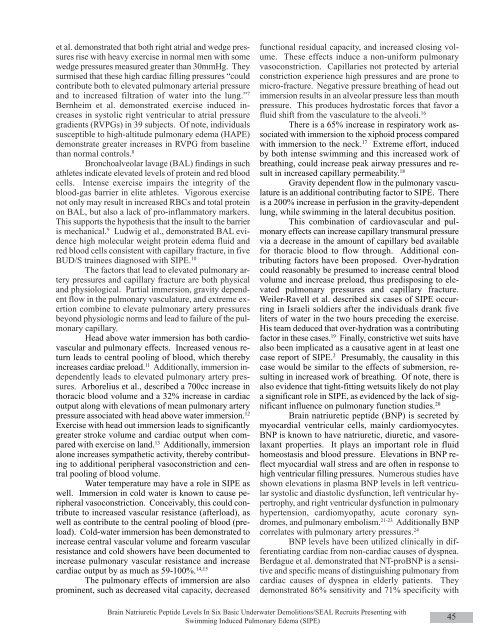Summer - United States Special Operations Command
Summer - United States Special Operations Command
Summer - United States Special Operations Command
Create successful ePaper yourself
Turn your PDF publications into a flip-book with our unique Google optimized e-Paper software.
et al. demonstrated that both right atrial and wedge pressuresrise with heavy exercise in normal men with somewedge pressures measured greater than 30mmHg. Theysurmised that these high cardiac filling pressures “couldcontribute both to elevated pulmonary arterial pressureand to increased filtration of water into the lung.” 7Bernheim et al. demonstrated exercise induced increasesin systolic right ventricular to atrial pressuregradients (RVPGs) in 39 subjects. Of note, individualssusceptible to high-altitude pulmonary edema (HAPE)demonstrate greater increases in RVPG from baselinethan normal controls. 8Bronchoalveolar lavage (BAL) findings in suchathletes indicate elevated levels of protein and red bloodcells. Intense exercise impairs the integrity of theblood-gas barrier in elite athletes. Vigorous exercisenot only may result in increased RBCs and total proteinon BAL, but also a lack of pro-inflammatory markers.This supports the hypothesis that the insult to the barrieris mechanical. 9 Ludwig et al., demonstrated BAL evidencehigh molecular weight protein edema fluid andred blood cells consistent with capillary fracture, in fiveBUD/S trainees diagnosed with SIPE. 10The factors that lead to elevated pulmonary arterypressures and capillary fracture are both physicaland physiological. Partial immersion, gravity dependentflow in the pulmonary vasculature, and extreme exertioncombine to elevate pulmonary artery pressuresbeyond physiologic norms and lead to failure of the pulmonarycapillary.Head above water immersion has both cardiovascularand pulmonary effects. Increased venous returnleads to central pooling of blood, which therebyincreases cardiac preload. 11 Additionally, immersion independentlyleads to elevated pulmonary artery pressures.Arborelius et al., described a 700cc increase inthoracic blood volume and a 32% increase in cardiacoutput along with elevations of mean pulmonary arterypressure associated with head above water immersion. 12Exercise with head out immersion leads to significantlygreater stroke volume and cardiac output when comparedwith exercise on land. 13 Additionally, immersionalone increases sympathetic activity, thereby contributingto additional peripheral vasoconstriction and centralpooling of blood volume.Water temperature may have a role in SIPE aswell. Immersion in cold water is known to cause peripheralvasoconstriction. Conceivably, this could contributeto increased vascular resistance (afterload), aswell as contribute to the central pooling of blood (preload).Cold-water immersion has been demonstrated toincrease central vascular volume and forearm vascularresistance and cold showers have been documented toincrease pulmonary vascular resistance and increasecardiac output by as much as 59-100%. 14,15The pulmonary effects of immersion are alsoprominent, such as decreased vital capacity, decreasedfunctional residual capacity, and increased closing volume.These effects induce a non-uniform pulmonaryvasoconstriction. Capillaries not protected by arterialconstriction experience high pressures and are prone tomicro-fracture. Negative pressure breathing of head outimmersion results in an alveolar pressure less than mouthpressure. This produces hydrostatic forces that favor afluid shift from the vasculature to the alveoli. 16There is a 65% increase in respiratory work associatedwith immersion to the xiphoid process comparedwith immersion to the neck. 17 Extreme effort, inducedby both intense swimming and this increased work ofbreathing, could increase peak airway pressures and resultin increased capillary permeability. 18Gravity dependent flow in the pulmonary vasculatureis an additional contributing factor to SIPE. Thereis a 200% increase in perfusion in the gravity-dependentlung, while swimming in the lateral decubitus position.This combination of cardiovascular and pulmonaryeffects can increase capillary transmural pressurevia a decrease in the amount of capillary bed availablefor thoracic blood to flow through. Additional contributingfactors have been proposed. Over-hydrationcould reasonably be presumed to increase central bloodvolume and increase preload, thus predisposing to elevatedpulmonary pressures and capillary fracture.Weiler-Ravell et al. described six cases of SIPE occurringin Israeli soldiers after the individuals drank fiveliters of water in the two hours preceding the exercise.His team deduced that over-hydration was a contributingfactor in these cases. 19 Finally, constrictive wet suits havealso been implicated as a causative agent in at least onecase report of SIPE. 2 Presumably, the causality in thiscase would be similar to the effects of submersion, resultingin increased work of breathing. Of note, there isalso evidence that tight-fitting wetsuits likely do not playa significant role in SIPE, as evidenced by the lack of significantinfluence on pulmonary function studies. 20Brain natriuretic peptide (BNP) is secreted bymyocardial ventricular cells, mainly cardiomyocytes.BNP is known to have natriuretic, diuretic, and vasorelaxantproperties. It plays an important role in fluidhomeostasis and blood pressure. Elevations in BNP reflectmyocardial wall stress and are often in response tohigh ventricular filling pressures. Numerous studies haveshown elevations in plasma BNP levels in left ventricularsystolic and diastolic dysfunction, left ventricular hypertrophy,and right ventricular dysfunction in pulmonaryhypertension, cardiomyopathy, acute coronary syndromes,and pulmonary embolism. 21-23 Additionally BNPcorrelates with pulmonary artery pressures. 24BNP levels have been utilized clinically in differentiatingcardiac from non-cardiac causes of dyspnea.Berdague et al. demonstrated that NT-proBNP is a sensitiveand specific means of distinguishing pulmonary fromcardiac causes of dyspnea in elderly patients. Theydemonstrated 86% sensitivity and 71% specificity withBrain Natriuretic Peptide Levels In Six Basic Underwater Demolitions/SEAL Recruits Presenting withSwimming Induced Pulmonary Edema (SIPE)45
















